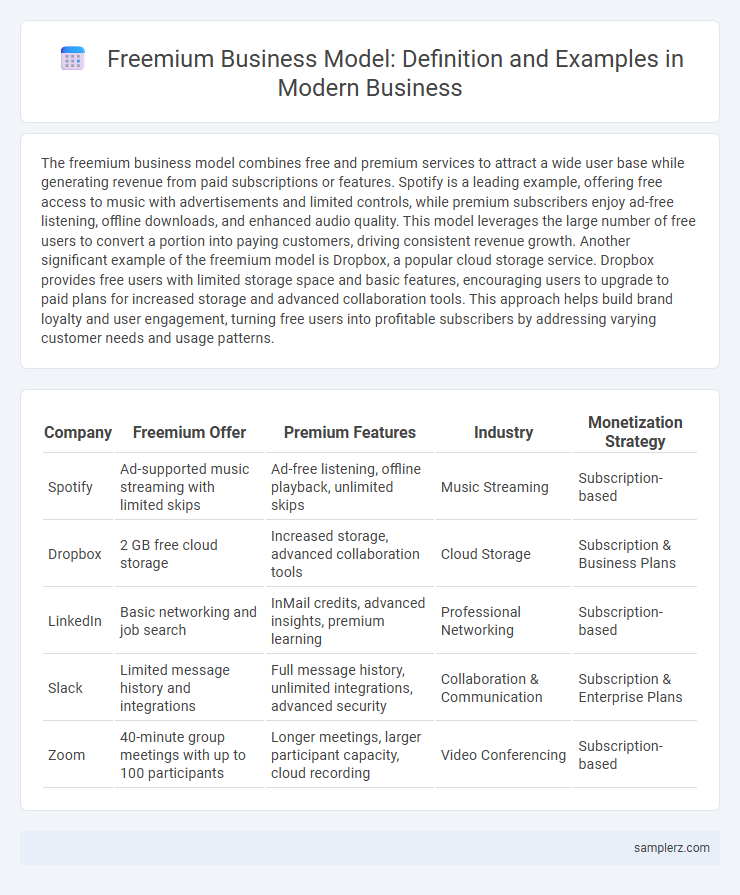The freemium business model combines free and premium services to attract a wide user base while generating revenue from paid subscriptions or features. Spotify is a leading example, offering free access to music with advertisements and limited controls, while premium subscribers enjoy ad-free listening, offline downloads, and enhanced audio quality. This model leverages the large number of free users to convert a portion into paying customers, driving consistent revenue growth. Another significant example of the freemium model is Dropbox, a popular cloud storage service. Dropbox provides free users with limited storage space and basic features, encouraging users to upgrade to paid plans for increased storage and advanced collaboration tools. This approach helps build brand loyalty and user engagement, turning free users into profitable subscribers by addressing varying customer needs and usage patterns.
Table of Comparison
| Company | Freemium Offer | Premium Features | Industry | Monetization Strategy |
|---|---|---|---|---|
| Spotify | Ad-supported music streaming with limited skips | Ad-free listening, offline playback, unlimited skips | Music Streaming | Subscription-based |
| Dropbox | 2 GB free cloud storage | Increased storage, advanced collaboration tools | Cloud Storage | Subscription & Business Plans |
| Basic networking and job search | InMail credits, advanced insights, premium learning | Professional Networking | Subscription-based | |
| Slack | Limited message history and integrations | Full message history, unlimited integrations, advanced security | Collaboration & Communication | Subscription & Enterprise Plans |
| Zoom | 40-minute group meetings with up to 100 participants | Longer meetings, larger participant capacity, cloud recording | Video Conferencing | Subscription-based |
Introduction to Freemium Business Models
Freemium business models offer basic services or products for free while charging for premium features, upgrades, or add-ons, attracting a large user base with no initial cost. Companies like Spotify and LinkedIn effectively use freemium strategies by providing core functionalities at no charge and generating revenue through subscriptions or advanced features. This approach balances user acquisition with monetization, driving sustainable growth in competitive markets.
Key Features of the Freemium Approach
The freemium business model offers basic services or products for free while charging for premium features such as advanced functionalities, enhanced customer support, or ad-free experiences. Key features include tiered access levels, user engagement through free offerings, and the strategic conversion of free users to paying customers by demonstrating added value. This approach leverages scalability and broad market reach to maximize revenue potential while minimizing customer acquisition costs.
Benefits of the Freemium Model for Businesses
The freemium business model offers companies significant advantages such as rapid user acquisition by providing free access to basic features, which lowers entry barriers for potential customers. This approach enables businesses to gather valuable user data and feedback, facilitating product improvements and targeted upgrades to premium offerings. Furthermore, converting a percentage of free users into paying customers creates a scalable revenue stream without substantial upfront marketing costs.
Popular Freemium Success Stories
Spotify exemplifies a popular freemium success story by offering free streaming with ads and premium subscriptions for ad-free listening and offline access. LinkedIn leverages the freemium model by providing basic networking features for free while charging for premium tools like InMail and advanced insights. Dropbox gained massive user growth by offering free cloud storage with paid plans for increased capacity and enhanced collaboration features.
SaaS Industry: Freemium Examples
SaaS companies like Dropbox and Slack effectively use the freemium business model by offering basic features for free while charging for premium tiers with advanced functionalities and increased storage or user limits. This strategy drives user acquisition and conversion by allowing customers to experience the core value before committing financially. Freemium models in SaaS also enhance customer retention through continuous feature updates and scalable pricing plans.
Freemium in Mobile Apps and Gaming
Freemium in mobile apps and gaming offers basic features or limited gameplay for free while charging for premium content, advanced tools, or in-game purchases. Popular examples include Spotify, which provides free music streaming with ads and limits, and Fortnite, allowing free play but monetizing through cosmetic upgrades and battle passes. This model drives user acquisition by lowering entry barriers while generating revenue from engaged users seeking enhanced experiences.
Media and Entertainment: Freemium Innovations
Streaming platforms like Spotify and YouTube exemplify freemium innovations in Media and Entertainment by offering free access with ads alongside premium subscriptions for ad-free experiences and exclusive content. These models leverage user engagement through basic features to convert a portion into paying subscribers, boosting revenue and enhancing customer loyalty. Integrating interactive elements such as offline downloads and high-definition streaming further differentiates premium tiers in this competitive market.
Core Challenges in Implementing Freemium
Freemium business models often struggle with converting free users into paying customers due to unclear value differentiation between tiers. Balancing infrastructure costs while maintaining quality service for a large free user base presents significant financial strain. Effective user engagement strategies and continuous feature improvements are essential to overcoming these monetization and scalability challenges.
Monetization Strategies Beyond Basic Freemium
In the freemium business model, companies like Spotify generate revenue through tiered subscription plans, offering premium features such as ad-free listening, offline access, and enhanced sound quality. In-app purchases and exclusive content downloads further monetize beyond the basic free service. Data analytics and targeted advertising also provide strategic revenue streams by leveraging user behavior insights.
Future Trends in the Freemium Business Model
The future trends in the freemium business model reveal a shift towards hyper-personalization powered by AI, enabling businesses to tailor premium features based on individual user behavior and preferences. Integration of blockchain technology promises transparent and secure microtransactions within freemium platforms, enhancing user trust and engagement. Subscription-based freemium models combined with data analytics will drive adaptive pricing strategies, optimizing revenue streams while maintaining broad user accessibility.

example of freemium in business model Infographic
 samplerz.com
samplerz.com